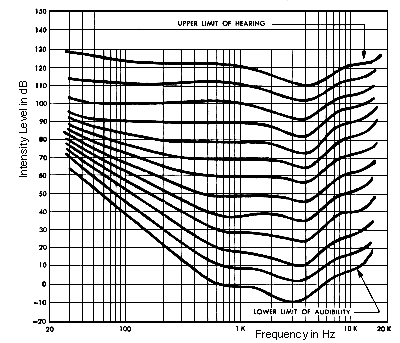
 |
Equal Loudness Contours |
The ear is not equally sensitive to all frequencies, particularly in the low and high frequency ranges. The response to frequencies over the entire audio range has been charted, originally by Fletcher and Munson in 1933, with later revisions by other authors, as a set of curves showing the sound pressure levels of pure tones that are perceived as being equally loud. The curves are plotted for each 10 dB rise in level with the reference tone being at 1 kHz. Also called loudness level contours and the Fletcher-Munson curves.
The curves are lowest in the range from 1 to 5 kHz, with a dip at 4 kHz, indicating that the ear is most sensitive to frequencies in this range. The intensity level of higher or lower tones must be raised substantially in order to create the same impression of loudness. The phon scale was devised to express this subjective impression of loudness, since the decibel scale alone refers to actual sound pressure or sound intensity levels.
Historically, the A, B, and C weighting networks on a Sound Level Meter were derived as the inverse of the 40, 70 and 100 dB Fletcher-Munson curves and used to determine Sound Level.
The lowest curve repesents the threshold of hearing, the highest the threshold of pain.
See also: Loudness Level, Presence, Sone, Volume. Compare: Flat, Noise Criterion, Noise Rating, Perceived Noise Level.

Curves based on the studies of Fletcher and Munson showing the response of the human hearing mechanism as a function of frequency and Loudness Levels. Compare the modern equivalent under phon.
Ramp of 12 steps of 3 dB each at the following frequencies: (1) 50 Hz; (2) 500 Hz; (3) 4000 Hz. Count the number of steps you can hear, the frequency with the greatest number being the one where the ear is most sensitive.